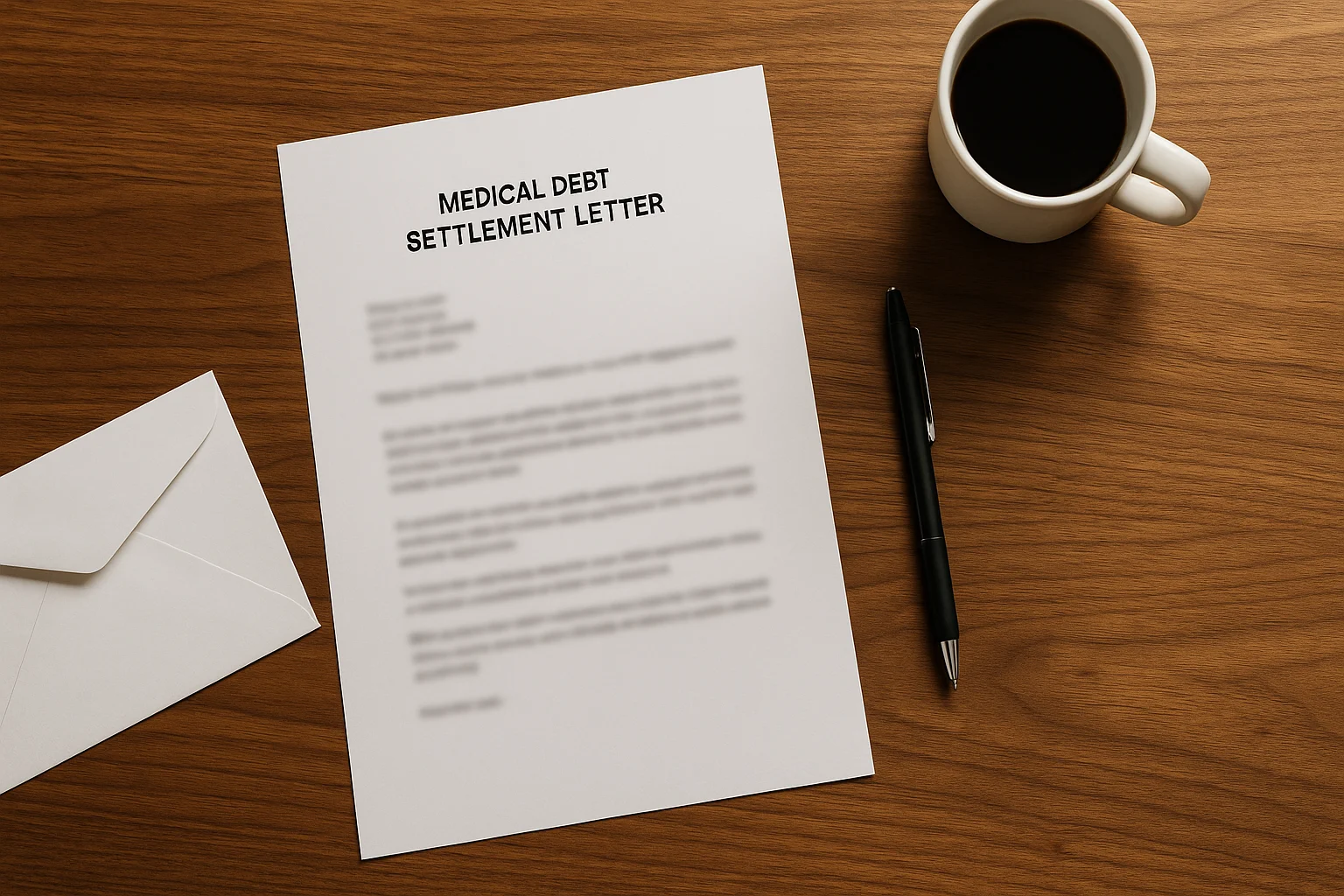
Struggling with medical bills? A medical debt settlement letter can slash what you owe—sometimes by half—without wrecking your budget. For example, Sarah, a single mom from Ohio, settled a $5,000 hospital bill for $2,000 using this approach. In this guide, you’ll learn the essentials, see what works, and use our free generator to create your letter in minutes. Ready to take control? Let’s dive in.
Create Your Medical Debt Settlement Letter!Table of Contents
- Key Takeaways for Settling Medical Debt
- Understanding Medical Debt Settlement
- Why You Should Write a Medical Debt Settlement Letter
- Preparing to Write Your Settlement Letter
- How to Write a Medical Debt Settlement Letter
- Free Medical Debt Settlement Letter Template Generator
- What Happens After You Send the Letter?
- Impact on Your Credit Score
- Tax Implications of Debt Settlement
- Keeping Meticulous Records
- Frequently Asked Questions
- Final Steps for Your Letter
Key Takeaways for Settling Medical Debt
- You Can Negotiate: Hospitals and collection agencies often accept less than the original amount, especially for lump sums.
- Written Offers Matter: A written settlement letter documents your offer and protects your interests.
- Explain Hardship: Highlight reasons like job loss or high medical costs to strengthen your case.
- Offer Strategically: Aim for 20–50% of the debt, but be ready to negotiate.
- Protect Yourself: Always get written agreements before paying and understand tax implications.
Understanding Medical Debt Settlement
So, what exactly is a medical debt settlement letter? It’s a formal offer to pay a portion of your bill in exchange for full satisfaction of the balance. For instance, if you owe $1,000, you might offer $300 to settle. Providers often prefer some payment over none because collecting old debt is costly and slow.
Why Providers Agree to Settle Medical Debt
- Collecting costs money: Tracking down unpaid bills takes time, staff, and resources.
- Quick payment matters: A one-time payment, even if smaller, gets them money fast.
- Relationship value: Some providers want to stay on good terms with patients.
- Old balances are hard to recover: The longer a bill goes unpaid, the harder it is to collect.
“Medical bills can feel like a heavy weight, but a medical debt settlement letter can unlock big savings and give you a fresh start.”

Why You Should Write a Medical Debt Settlement Letter
Sure, a phone call might get the conversation going, but putting your offer in writing is a game-changer. Here’s why it’s so important:
- It shows you mean business: A polished letter proves you’re serious about sorting out the debt.
- Keeps everything on record: Your letter documents your offer and terms, so there’s no confusion later.
- Clear communication: Writing it down ensures your proposal is straightforward and avoids mix-ups.
Always send your letter via certified mail with a return receipt to prove delivery. This step ensures your records are airtight.
Preparing to Write Your Settlement Letter
Before you start, gather the key details you’ll need to make your letter compelling. Here’s what to collect:
Identify the Creditor
First, determine who owns the debt—hospital, doctor’s office, or collection agency. If the debt has been sold multiple times, contact the most recent agency. Get their full legal name and mailing address.
Gather Your Debt Details
- Account Number: This pinpoints your specific bill.
- Original Amount: The full amount you were initially charged.
- Date of Service: When you received the medical care.
- Current Balance: What you owe right now.
- Debt Age: Older debts are often easier to negotiate since they’re harder for creditors to collect.
Take a Hard Look at Your Finances
Next, sit down and review your money situation. Check your income, monthly expenses, savings, and any other debts to figure out what you can realistically offer. For example, if you’re barely covering rent and groceries, jot that down—it’ll strengthen your hardship explanation when you write your letter and consider debt repayment strategies to prioritize your medical debt.
Review Bills and Insurance
Finally, check for billing errors or insurance misprocessing by comparing your bill with your Explanation of Benefits (EOB). Learn more about EOBs from the CFPB.
How to Write a Medical Debt Settlement Letter
Now, let’s craft a clear, professional letter. Follow these steps:
Your Contact Information
Include your full name, address, phone number, email (optional), and the date at the top left.
Creditor’s Information
List the creditor or collection agency’s name and address below your details.
Salutation and Subject Line
Use a formal greeting (e.g., “Dear Billing Department”) and a clear subject line: “Offer to Settle Account Number [Your Account Number].”
State Your Intent
Begin by referencing the account number, date of service, and original debt amount. For example: “I’m writing about account number [Your Account Number] for services on [Date], with an original balance of $[Amount].”
Explain Your Hardship
Briefly describe your financial hardship (e.g., job loss, high medical costs) without oversharing. Avoid admitting the debt’s validity if you dispute it. Example: “Due to a recent layoff, I cannot pay the full balance of $[Amount].”
Propose Your Offer
Offer 20–50% of the debt as a lump sum for the best chance of acceptance. Alternatively, propose a payment plan if needed. Example: “I offer a lump sum of $[Amount] as full settlement, to be reported as ‘paid in full’ to credit bureaus.”
Request Written Confirmation
Insist on a written agreement before paying. Include: “Please confirm in writing that this payment settles the debt in full and halts collection activity.”
Add a Confidentiality Clause (Optional)
Request that settlement terms remain confidential: “The terms of this settlement should remain confidential.”
Professional Closing
End with “Sincerely,” your signature, and typed name.
“A well-written medical debt settlement letter can save you thousands, but always get the agreement in writing first.”

Free Medical Debt Settlement Letter Template Generator
Create Your Letter
Fill in the fields below to create your medical debt settlement letter instantly.
Your Letter Draft
Review and edit before sending. Download below.
Tips: 💡 Offer 20–50% of the debt and send via certified mail for best results.
What Happens After You Send the Letter?
Once you’ve sent the letter, here’s what to expect and how to proceed.
Waiting Period
Allow 2–4 weeks for a response. Monitor your mail and keep your certified mail receipt handy.
Possible Responses
- Acceptance: They agree to your terms. Wait for written confirmation before paying.
- Counter-Offer: They propose a higher amount or different terms. Negotiate or accept if affordable.
- Rejection: They decline your offer. Call to understand why or send a revised, higher offer.
- No Response: Follow up after 3–4 weeks, referencing your certified mail receipt.
Negotiating Effectively
If they counter-offer, assess your budget. For instance, if you offered $300 on a $1,000 debt and they counter with $500, you might propose $400. Always confirm agreements in writing. Reading success stories can inspire you to stay persistent.
Securing the Agreement
Before paying, ensure the written agreement specifies the settlement amount, “full and final settlement,” and credit reporting terms (e.g., “paid in full”).

Impact on Your Credit Score
Settling medical debt can affect your credit score, but here’s what you need to know.
Medical Debt and Credit Reports
Medical debt typically doesn’t hit your credit report until it goes to collections. Recent rules (as of 2023) help:
- Paid medical collection debt is removed from reports.
- Debts under $500 are no longer reported.
- Unpaid medical debts have a one-year delay before appearing.
How Settlement Appears
A settled debt may be reported as “settled for less” or “paid in full.” Negotiate for “paid in full” to minimize credit impact. Negative marks can stay for seven years but fade over time.
Tax Implications of Debt Settlement
When you settle for less, the forgiven amount may be taxable income. For example, settling a $2,000 debt for $800 means $1,200 could be taxable. However, if your debts exceed your assets (insolvency), you may avoid taxes. For instance, if you owe $10,000 but your assets are worth $5,000, you might qualify. Consult a tax professional to avoid surprises.
Keeping Meticulous Records
Keep every document related to your settlement and correspondence:
- Original bills and EOBs
- Your sent letter and certified mail receipt
- Creditor’s written agreement
- Proof of payment
- All correspondence
Store these in a dedicated folder for at least seven years to protect against future disputes.
Frequently Asked Questions
Final Steps for Your Letter
You’re ready to act. Here’s how to finalize and send your letter:
- Print and Sign: Review your letter for errors and sign it in blue or black ink.
- Make Copies: Keep at least two copies of the signed letter.
- Include Enclosures: Add copies of supporting documents (e.g., proof of hardship), not originals.
- Send Certified Mail: Use certified mail with return receipt for proof of delivery.
- Follow Up: If no response in 3–4 weeks, call with your tracking number.
- Stay Organized: File all documents in a dedicated folder.
With a strong, well-documented letter, you can take control and potentially save thousands. You’ve got this!
This content is for informational purposes only and not financial advice. Consult a professional before making financial decisions.

